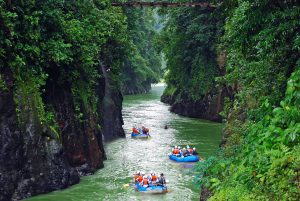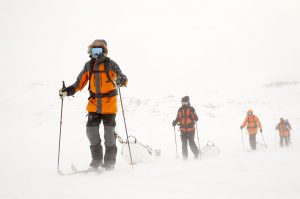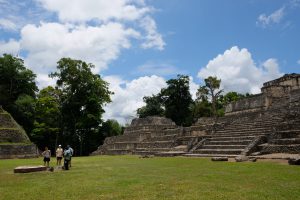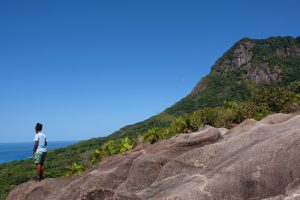
With superlative natural beauty, enduring indigenous traditions and a fast-growing economy, Bolivia is about to have its moment in the spotlight, says Amelia Duggan
View online at worldwidedestinationguide.com
“How much for… that?” I ask in my best Spanish, nervously pointing past the hanging display of dried llama fetuses and between two large jars of reddish powder. The aged shopkeeper beams at me from under her bowler hat (revealing a surprising number of gold teeth) and lurches out of her shop’s gloomy doorway to show me the object of my enquiry: a small, angular carving of a bird, roughly chiseled out of dusty soapstone.
Up close, it’s terrifying: mean, teardrop eyes and a hooked beak, with a man’s face protruding from its belly, and tomahawk wings. She jabs me repeatedly in the chest with her finger as she rattles off a list of the gargoyle’s lucky properties. Good health. Protection. Good husband. Wealth. Before I know it, the stone charm is threaded with red string and looped around my neck, and I’m parting with several dollars-worth of Bolivianos. I’m slightly mystified as to how this happened, but I suppose I could have come off worse from a first encounter with a witch.
It’s my first day in La Paz and I’ve stumbled into La Hechiceria — the infamous Witches’ Market — a hilly junction of cobbled streets where dark-eyed yatiri (witch doctors) with pouches of cocoa leaves offer to tell your fortune, and bizarre ingredients are sold to be used in ancient native rituals. Bolivia’s population has the highest proportion of indigenous people of any South American country — nearly two-thirds belong to one of 36 ethnic groups. And while around 80% of Bolivians are Catholic, the spirits of the pre-Incan cosmos are omnipresent. I witness a suited man and his cholita wife — resplendent in her traditional velveteen petticoats, tasseled shawl, twin plaits and precariously perched hat — order one of the shriveled unborn llamas to go. They must be building; these cadavers are buried in the foundations of new homes as a cha’lla (offering) to the volatile earth goddess Pachamama.
I brave the snarling traffic aboard a bus heading further downtown. Outside, the city sweeps past in dizzying colors: ramshackle buildings, leafy plazas, street jugglers, shoe-shiners and pungent, steaming food carts selling saltenas (meat-filled pastries). My head swims with the sheer spectacle — or perhaps that’s the altitude. At 12,000ft, La Paz is the world’s highest city, sitting atop the crest of South America’s mountainous spine. Its twisted streets are spun over the vertiginous topography of a vast canyon; buildings climbing the near-vertical escarpments in gravity-defying feats of engineering. From La Paz, Bolivia spreads east to the arid, low-lying plains of the Gran Chaco and the Amazon rainforest.
Traditionally, the country has lagged behind its more affluent neighbors in the tourism stakes but this is set to change. A decade of political stability under president Evo Morales has led to unprecedented financial growth, which has meant a reduction in the proportion of the population living in poverty (today, still a startling 40%, but this is 20% less than in 2001) and significant improvements in infrastructure and tourist facilities. In La Paz, the signs of this transformation are palpable. Three sets of airborne gondolas were strung up across the city in 2014 (red, yellow and green, for the Bolivian flag, with six more lines planned), connecting the clifftop dwellings and the recently renovated El Alto airport with the city below. And with growing foreign investment in hotels and eateries, it’s now easier than ever to live the high life in lofty La Paz. A gourmet revolution was kick-started in 2013, when the co-founder of Stockholm’s most-lauded eatery, Noma, opened Gustu (the Quechua word for ‘flavor’) in the Calacoto neighborhood, using only native ingredients. Since then, a number of cooking schools and food tours have sprung up, celebrating local dishes like tucumanas (fried empanadas) and anticuchos (grilled beef-heart).
Further afield, the road connecting the city of Potosi with the judicial capital, Sucre, was repaved a few years ago, making travel between these hubs faster and safer. The landing strip at the southern town of Uyuni also now has a terminal, runway and multiple daily flights from La Paz, better connecting the administrative capital to one of the country’s greatest natural attractions: the desolate beauty of the southern Altiplano, home to the world’s largest salt flat.
These rugged, wild borderlands provided my first taste of Bolivia. I’d crossed the Chilean border a week ago aboard a 4WD vehicle as part of a four-day group tour of the area; our driver careering between remote guesthouses through a mercurial landscape. Lush plains populated only by grazing alpacas gave way to a necklace of crystal lakes dotted with flamingos slowly fishing among the clouds’ reflections. One memorable night was spent beside the frosted waters of the raspberry-hued Laguna Colorada, 14,000ft above sea level, where the skies were clear enough to see the arc of the Milky Way. On the final morning, chilly, and feeling the effects of the extreme altitude, our group watched the sun rise over the Salar de Uyuni — 4,086sq miles of blinding white salt. The low sun cast long shadows behind us, slowly revealing the immensity of the ancient dry lakebed. The coarse, solid salt was scored into large hexagons, like tiles laid by gods, stretching in every direction to a misty frieze of jagged mountains on the horizon. Exiting these expansive alien wilds and rolling into bone-cold Uyuni — a town with a forlorn, frontier feel — felt like returning to Earth from space.
As I step off the coach from La Paz the next day, it’s immediately clear that Copacabana is in the middle of a fiesta. The streets are festooned with color, and there’s an orderly queue of cars snaking through the main plaza — each decked out in plastic garlands of flowers, miniature trumpets, rosettes and, occasionally, little bowler hats.
Dipping my head into a truck window, I beg an explanation from the driver. It’s the feast day of Bolivia’s patron saint, the Virgen de Copacabana, he says, thoroughly entertained by my ignorance. Crossing the large piazza and leaving the hubbub behind, I slip into the Basilica of Our Lady of Copacabana. The gold fixtures, lustrous oil paintings and soaring arches glow softly in dim light. My guidebook informs me I’m in the presence of the country’s most famous effigy. Heading up a small staircase, I come face to face with the Virgin of Copacabana. Four-foot high, heavy-lidded and rouged, she stares intently out of her glass case, swathed in the uncomfortable-looking brocade robe of an Inca princess. Locals believe her presence is all that prevents the lake from rising in an apocalyptic flood. So strong is this superstition that when thieves ransacked the sanctuary for its gold and gems in 2013, they left the priceless Virgin undisturbed.
Outside, the town unfolds in an architectural jumble of souvenir shops and guesthouses. Beyond lies a sweeping crescent shoreline, after which the landscape dissolves into a cobalt expanse of shimmering water and cloudless sky. This is Lake Titicaca, the world’s highest lake. It’s a wondrous sight, and one the government has pledged to protect: in January 2016, Bolivia and Peru agreed a $500m deal to reduce pollution and protect the lake’s biodiversity.
Copacabana is the perfect place to kick back in. Here, languid days guzzling grilled trout drift into dusky evenings spent in yellow-lit bars. I’m loath to leave but I’ve been told that over the horizon lies an island humming with mystic energy and littered with pre-Colombian ruins. A place sacred to ancient Andean cultures and central to their mythologies – the birthplace of the sun, no less.
Isla del Sol welcomes our boat with a timber jetty and a beach dotted with sleeping piglets. We drop anchor in the north, near the breezeblock hamlet of Challapampa. Here, crops are still tended by hand and the campesinos (farmers) live simply; the steady stream of day-trippers has done little to alter a subsistence-farming culture dating back millennia. Climbing towards the island’s crest, the landscape is almost Aegean: terraced slopes lush with heather and eucalyptus wrap around undulating hills like gradient markers on a map.
The sun is high when we reach our destination: the Sacred Rock, where the Incas believed the first man and woman were created by the god Viracocha. It’s a craggy, pitted boulder offering the only shade in the clearing. Our guide points out the outline of a puma in the rutted rock face, then shows us to a large flat slab a short distance away (a sacrificial stone) where many a llama met its maker. I leave the group and come across a tumbledown stone labyrinth overlooking the water. There’s not a ripple on the lake and the silence is delicious.
Published in the spring 2016 issue of ASTA Network











